Phytoremediation: How plants clean our environment
The natural process through which plants transform toxic compounds into less harmful substances, and the sustainable solutions it provides.
The growing attention being paid to sustainability and environmental protection has led to the search for innovative solutions to tackle pollution. With this in mind, there have been several advancements that leverage natural processes to restore environmental quality, without using invasive or harmful methods. Among these, one of the most promising techniques is the use of living organisms to degrade or neutralise pollutants, offering an environmentally-friendly alternative to traditional methods, known as phytoremediation These natural processes can be an effective and sustainable solution to the challenge of environmental pollution.
Phytoremediation is a technique that uses the metabolism of microorganisms, plants, or fungi to degrade or detoxify pollutants in the environment. This technique harnesses the ability of these organisms to transform toxic compounds into less harmful substances through natural biological processes.
It is classed as a sustainable technology, using natural processes for remediation, reducing the need for hazardous chemicals and minimising environmental impact. Compared to other remediation techniques, such as incineration or the use of chemical agents, Phytoremediation requires less energy, and produces no harmful by-products. As a result, it is often better accepted by local communities compared to more invasive and artificial methods.
Phytoremediation processes
One of the main processes of phytoremediation is absorption, where plant roots absorb contaminants, such as heavy metals (e.g., lead, cadmium, and arsenic), from the soil or water. These contaminants can then be moved to the leaves and stems, where they accumulate or are further transformed. The use of this process for the removal of pollutants is known as phytoextraction. Once the plants have accumulated a significant amount of contaminants, they are harvested and safely disposed of.
Another key process is phytodegradation, which can occur either within the plant itself or through microbes in the soil near the roots. These microbes can degrade contaminants, transforming them into less toxic or even harmless compounds. This process is used to treat contaminants such as pesticides, organic solvents, and hydrocarbons.
Phytovolatilisation is when contaminants absorbed by plants are released into the atmosphere through the leaves. This process is particularly useful for treating contaminants such as mercury and selenium, which can be transformed into gaseous forms and released into the air. Although this method reduces the concentration of contaminants in soil and water, it is important to monitor air quality to avoid potential risks.
Phytostabilisation traps contaminants in the soil, reducing their mobility and preventing their spread in the environment. This method is effective for treating heavy metals and radioactive waste, preventing them from being transported through soil or water into the environment. Glomalin, a glycoprotein produced by arbuscular mycorrhizal fungi, plays an important role in this process. Glomalin is great at binding heavy metals and immobilising them in the soil. If you would like to learn more about glomalin, read our blog here.
Rhizofiltration is when aquatic plants absorb and concentrate contaminants present in water. This method takes advantage of the ability of roots to absorb and accumulate these contaminants. Plants used for rhizofiltration are often grown without soil, in what are known as hydroponic systems, as well as contaminated water basins, where they can be easily harvested and replaced once they have absorbed a significant amount of contaminants.
Lastly, phytostimulation is a process that increases the activity of the microbes in the root zone of the plants, which is known as the rhizosphere. Plant roots release compounds such as sugars, carbohydrates, amino acids, and organic acids, feed the microbes in the rhizosphere, increasing their presence and activity in breaking down contaminants. Plant roots also bring oxygen to the rhizosphere, aiding the process.
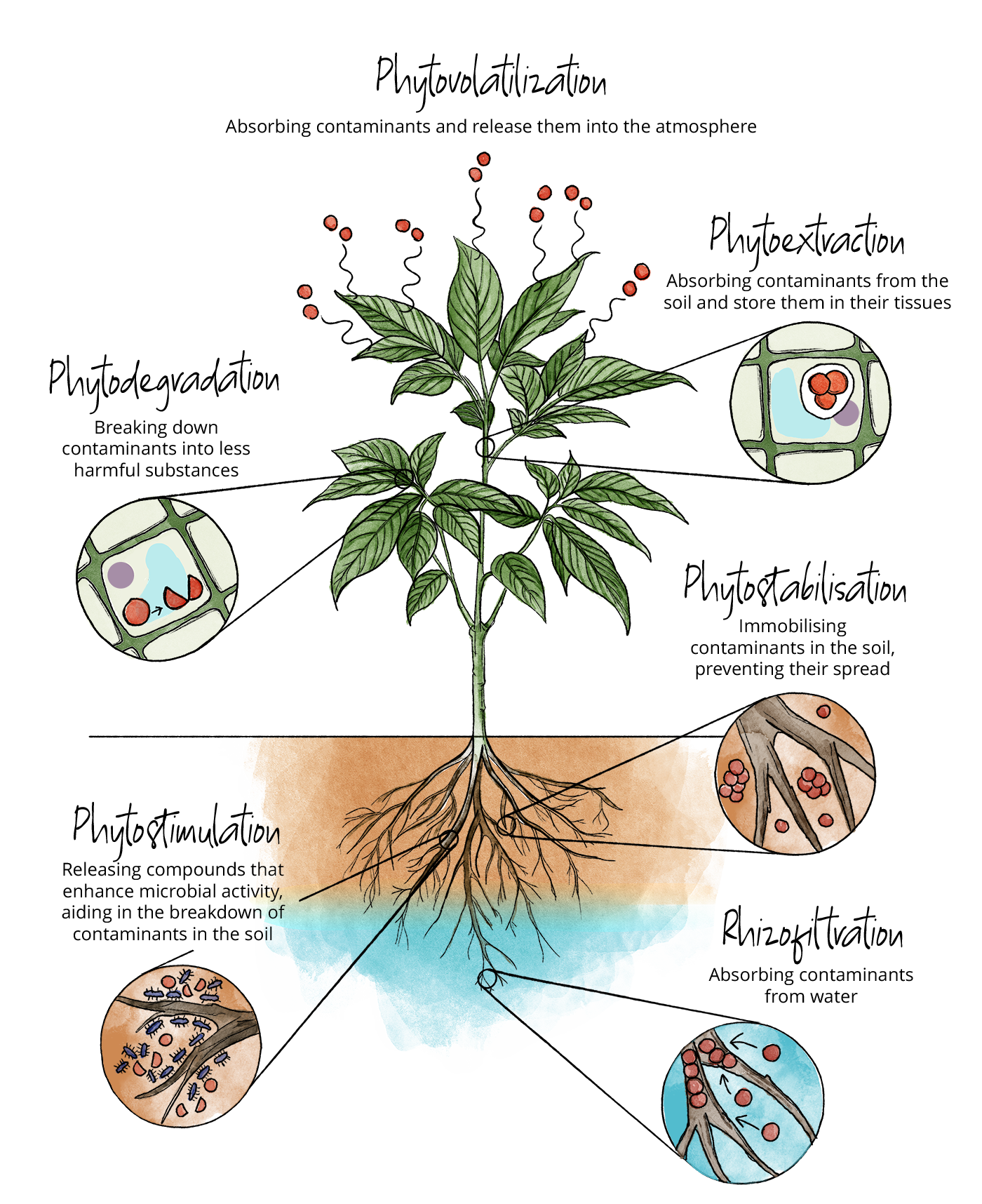
Phytoremediation in urban environments
Phytoremediation is becoming an effective solution to dealing with urban pollution. Urban environments have high levels of atmospheric pollutants, contaminated soils, and polluted surface waters, posing a significant challenge to public health and ecosystems. Urban soils are often variable in nature and low in fertility, making decontamination a challenge. The use of phytoremediation offers a sustainable way to mitigate urban pollution.
Plants for urban phytoremediation are chosen for their ability to tolerate and accumulate organic and inorganic contaminants. For example, species such as poplar and sunflower are known for their effectiveness in absorbing heavy metals from contaminated soils, while other plants, such as bulrush and reed, are used to purify polluted surface water. Plants used in phytoremediation can remove up to 95% of contaminants present in soils1.
Urban phytoremediation integrates well with other green infrastructure, such as parks, gardens, and green roofs. These not only improve air and soil quality but also offer visual interest and social benefits for the community.
Ornamental plants, although not always among the most effective in plants for urban remediation, can still absorb significant amounts of heavy metals through their roots and foliage. Ornamental grasses and some tree species, mainly chosen for their visual appeal, are often used in phytoremediation sites. Their rapid growth cycle allows for quick monitoring of responses to environmental stress.
Effective plants in Phytoremediation processes
Plants for phytoremediation must have a good resistance to both biotic stress, such as diseases and pests, and abiotic stress, such as high temperatures, drought, and high salinity. The ability to adapt and survive under such conditions changes among species and cultivars, resulting from long natural selection and artificial improvements made by nurseries and plant breeders. These plants can help mitigate air pollution by absorbing and metabolising pollutants through their leaves. Salt tolerance allows them to use low-quality water for irrigation, making them suitable for the remediation of saline soils contaminated with heavy metals. Drought resistance is also an excellent characteristic because it enables them to thrive in arid regions, reducing water consumption. If you are interested in the science of drought tolerance, read our blog here.
Below are some of our choices for effective species in phytoremediation:

Betula pendula
Betula pendula
Betula pendula has shown to be a useful species for the phytoremediation of soils contaminated with zinc (Zn). A study published in Ecological Engineering highlighted the ability of this plant to accumulate high amounts of zinc in its leaves, both in highly polluted environments and in those with background contamination. The presence of Betula pendula significantly reduced the zinc content in the surrounding soil compared to more distant areas, demonstrating its effectiveness in ‘cleaning’ contaminated soils. Betula pendula meets the necessary requirements for plants used in phytoremediation and could be included in the group of zinc hyperaccumulators, even though it is not often cited among hyperaccumulator species. Its growth in poor soils and its ability to accumulate metals make it suitable for practical applications in polluted environments. 2
Alnus glutinosa
A native, deciduous tree, able to absorb heavy metals such as cadmium. A recent study showed that, with increasing concentrations of cadmium in the soil, the content of this metal significantly increases in the roots, with a tolerance and accumulation capacity of up to 19.5 mg/kg of cadmium3
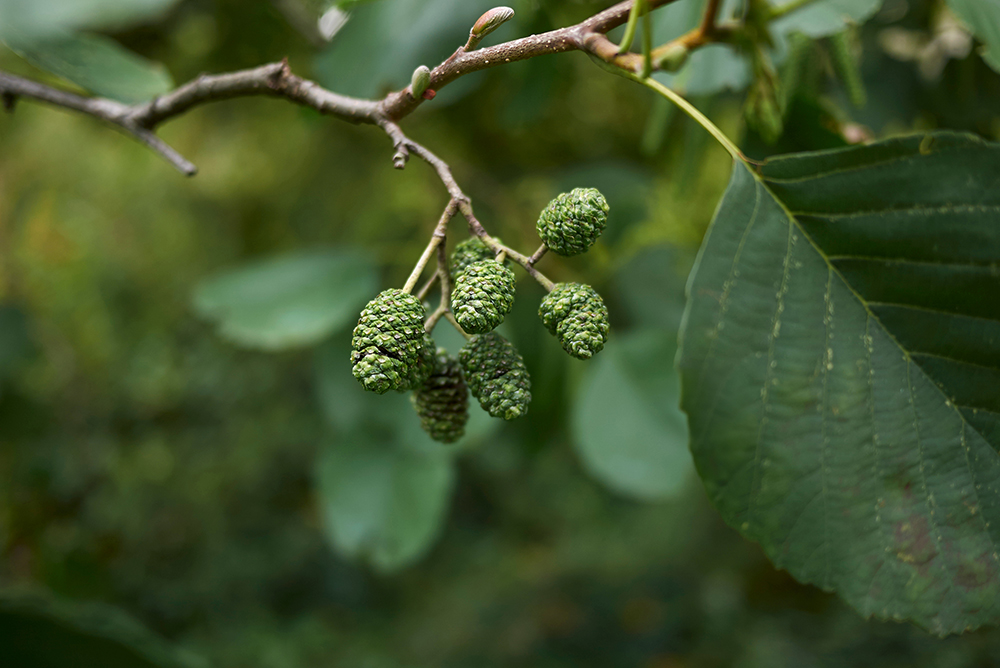
Alnus glutinosa
Festuca glauca
An ornamental grass that has significant phytoremediation capabilities, particularly for absorbing nickel. According to a recent study4, Festuca glauca can accumulate up to 275 mg/kg of nickel. Not only this, Festuca glauca can tolerate soils low in nutrients such as nitrogen and magnesium, being able to survive and grow in poor soil conditions. Festuca glauca is a plant of great interest for research and application in remediation and the sustainable management of contaminated soils.
Iris pseudacorus
A herbaceous perennial that is an effective absorber of contaminants, accumulating and tolerating heavy metals such as chromium and zinc. Studies found that iris plants exposed to nutrient solutions containing chromium and zinc showed an increase in the accumulation of these metals in all parts of the plant, with maximum concentrations in the roots5. Despite a reduction in growth, Iris pseudacorus was still able to function normally, making it a strong candidate for many urban cleaning applications.
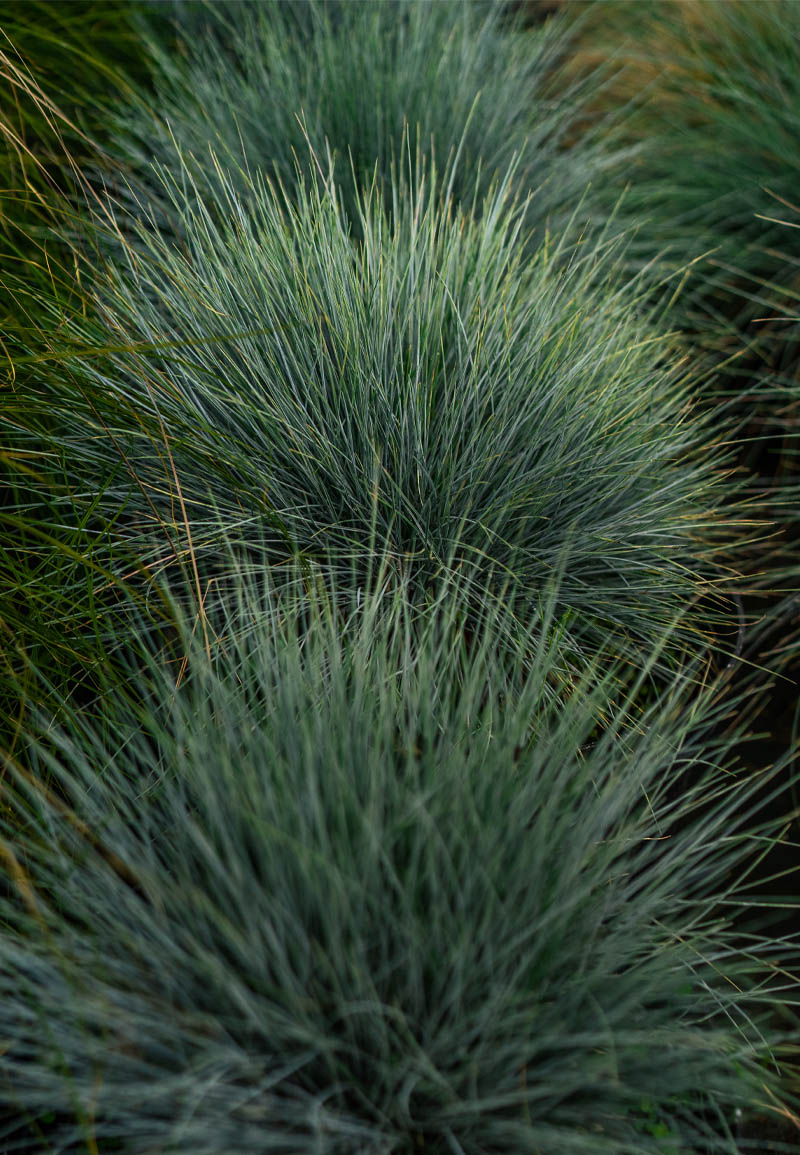
Festuca glauca ‘Elijah Blue’
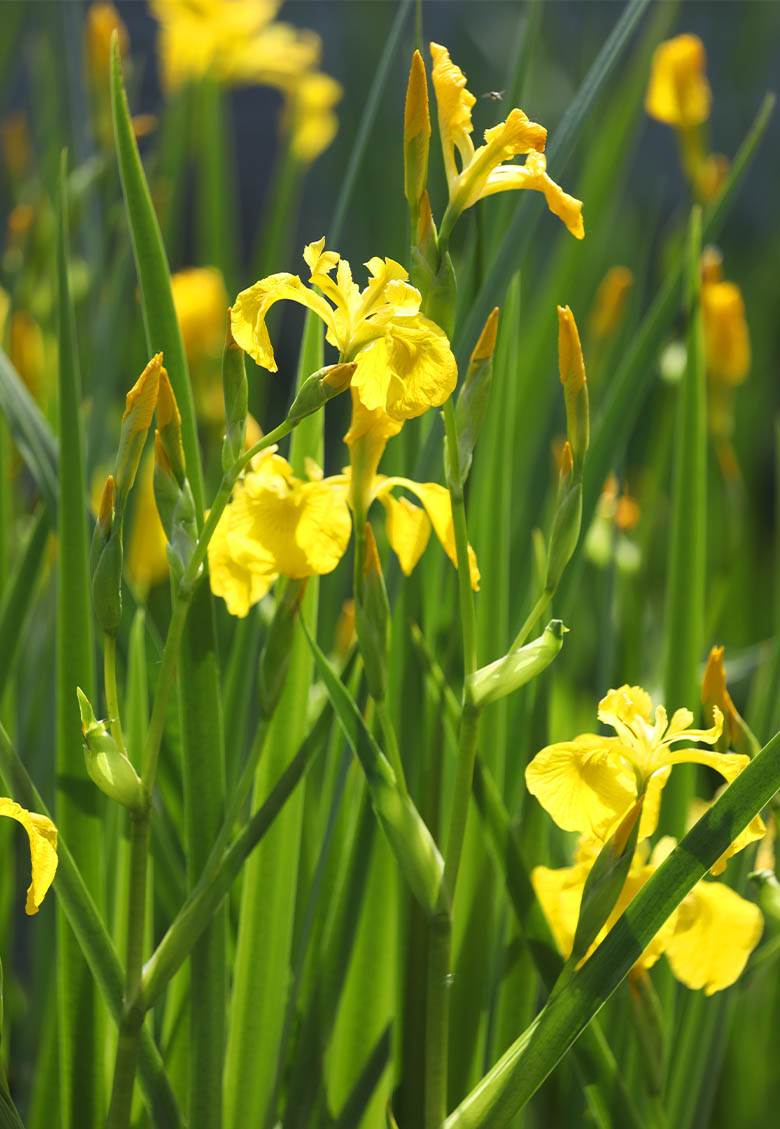
Iris pseudacorus
Hedera helix
Commonly known as ivy, this vigorous, self-clinging climber species can effectively absorb pollutant gases such as nitrogen dioxide. Using advanced tools to monitor the absorption of nitrogen dioxide by ivy, results showed that Hedera helix can significantly reduce the concentration of NO2 in the air, with a deposition rate of about 0.3 cm/s under light conditions6. This absorption is attributed to the plant’s stomatal activity, which allows the transport of the gas into cells where it is rapidly metabolised.
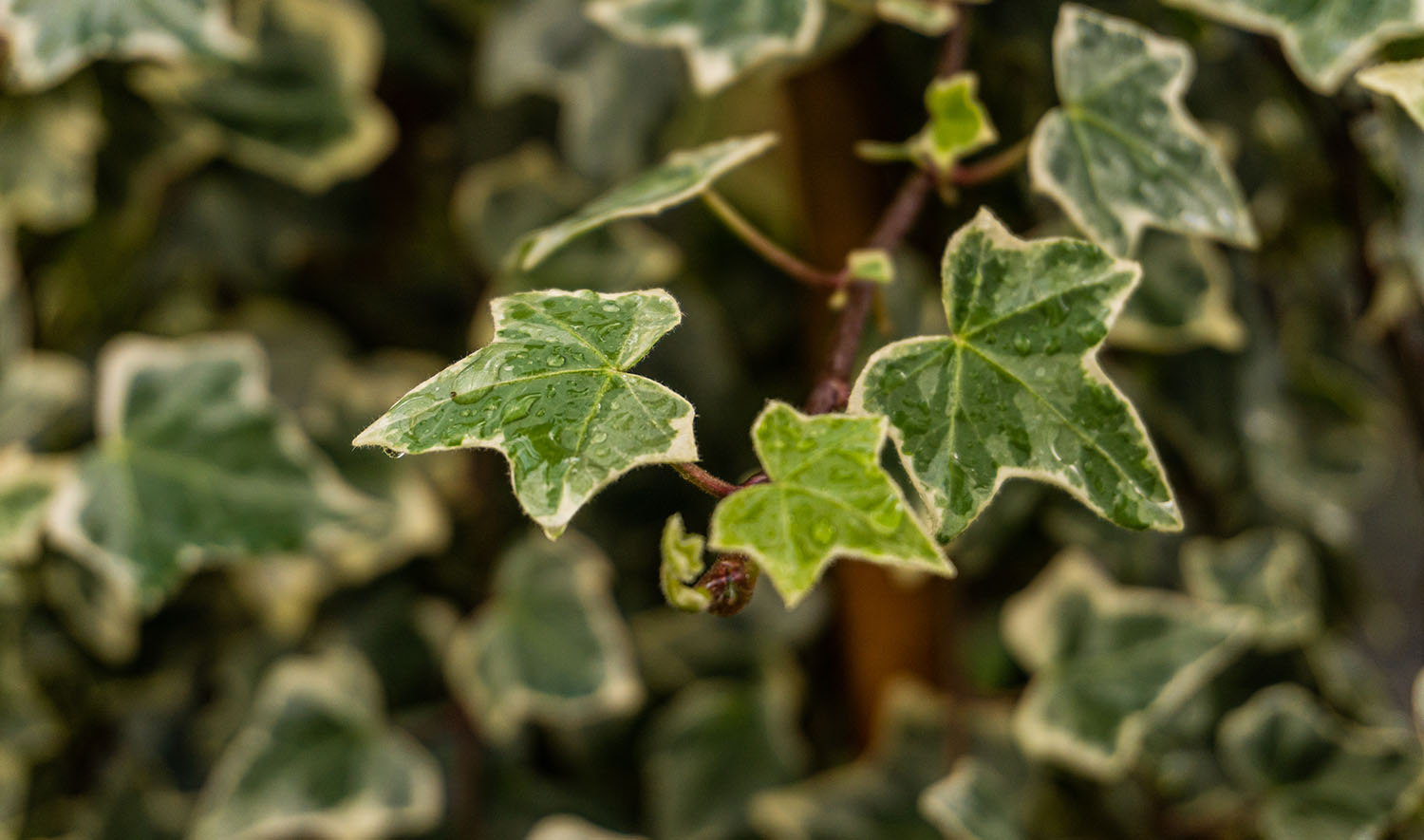
Hedera helix ‘Glacier’

Hedera helix
Benefits, limitations, and future challenges
One of the main benefits of phytoremediation is that it is generally less expensive compared to conventional methods. Traditional techniques, such as excavation and chemical treatment, require heavy machinery, costly chemicals, and the transport of contaminated materials. Phytoremediation utilises natural biological processes, significantly reducing operational costs. It can be applied in situ, avoiding additional expenses associated with the excavation and transport of contaminated soil. The plants used in phytoremediation can also be grown on marginal lands, unsuitable for agriculture, optimising land use and generating biomass that can be used for renewable energy production or other industrial purposes.
Phytoremediation also offers many environmental benefits. It is an ecological solution that does not alter the physical or chemical properties of the soil and can improve landscape quality, making remediated areas more appealing and biologically richer. The plants used can contribute to local biodiversity and soil stabilisation, preventing erosion, and can also improve air and water quality by reducing the concentration of contaminants.
Phytoremediation is not without its limitations however, with treatment times being longer and exceeding traditional techniques, and most remediation being limited to the root depth of the plants used. Despite these challenges, phytoremediation is a strong sustainable alternative for environmental remediation, with potential applications in urban, agricultural, and industrial contexts. Continuous research and technological innovation will help to improve the effectiveness of its use. With careful management, phytoremediation can significantly contribute to environmental protection and the promotion of economic and social sustainability.
Implementation in the UK
Phytoremediation offers many benefits for environmental policy in the UK, especially in increasing attention towards sustainable alternatives for decontamination. Using phytoremediation can help to achieving objectives set by the The Water Environment (Water Framework Directive), which includes bringing British water bodies to a ‘good status’ by 2027. Currently, only 15% of rivers and water bodies in England are classified as in ‘good status,’ a percentage which drops to 0% when considering updated pollution criteria. 7
The use of phytoremediation can reduce dependence on more invasive and costly chemical and physical methods, while simultaneously promoting biodiversity and improving the resilience of local ecosystems. This technology can be particularly useful for addressing pollution from heavy metals and antibiotics, which pose an increasing threat due to flood events related to climate change. Additionally, phytoremediation can be integrated into flood risk management policies, as plants can help stabilise soils and reduce erosion, mitigating the effects of climate change.
Another crucial aspect is the involvement of local communities in phytoremediation projects. This approach can increase environmental awareness and public support for eco-friendly remediation initiatives. Communities can be involved in the planting and maintenance of schemes, creating a sense of ownership and responsibility towards the local environment.
The implementation of phytoremediation can have long-term economic benefits, reducing the costs associated with traditional remediation and improving environmental quality. It can attract investments and promote sustainable development, contributing to improving the quality of life in urban areas, making green spaces more accessible and enjoyable for all.
References:
1. Zhu, Y., Gu, H., Li, H. et al.Phytoremediation of contaminants in urban soils: a review. Environ Chem Lett22, 355–371 (2024). https://doi.org/10.1007/s10311-023-01663-6
2. Dmuchowski, W., Gozdowski, D., Brągoszewska, P., Baczewska, A. H., & Suwara, I. (2014). Phytoremediation of zinc contaminated soils using silver birch (Betula pendula Roth). Ecological Engineering, 71, 32-35. https://doi.org/10.1016/j.ecoleng.2014.07.053
3. Nahvi, H., Torabian, S., Hashemi, S., & Payam, H. (2024). Alnus glutinosa (Alder) sapling as a phytoremediator for cadmium in contaminated soil of industrial park. Results in Engineering, 22, 102317. https://doi.org/10.1016/j.rineng.2024.102317
4. Bani, Aida & Imeri, Alma & Echevarria, Guillaume & Pavlova, Dolja & Reeves, Roger & Morel, Jean-Louis & Sulejman, Sulce. (2013). Nickel hyperaccumulation in the serpentine flora of Albania. Fresenius Environmental Bulletin. 22. https://www.researchgate.net/profile/Dolja-Pavlova/publication/250927362_Nickel_hyperaccumulation_in_the_serpentine_flora_of_Albania/links/00b7d520a2c02f2ea7000000/Nickel-hyperaccumulation-in-the-serpentine-flora-of-Albania.pdf
5. Caldelas, C., Araus, J. L., Febrero, A., & Bort, J. (2012). Accumulation and toxic effects of chromium and zinc in Iris pseudacorusL. Acta Physiologiae Plantarum, 34(4), 1217-1228. DOI: 10.1007/s11738-012-0956-4. https://diposit.ub.edu/dspace/bitstream/2445/120523/1/623525.pdf
6. Aduse-Poku, M., Rohrer, F., Winter, B., & Edelmann, H. G. (2024). Methodology for the quantification of the absorption potential of greenhouse – and pollutant gases by climbing plants used in façade greening; a case study on ivy (Hedera helix). Environmental Advances, 17, 100568. DOI: 10.1016/j.envadv.2024.100568. https://www.sciencedirect.com/science/article/pii/S2666765724000863
7. Bailey McCarthy Riley, John F. Malloy, Stephanie Piper, Theresa La – Phytoremediation Strategies for United Kingdom River Health in the Flood of Climate Change

